Have you ever wondered what makes your computer run? It’s not just the keyboard and monitors that make it all happen.
The motherboard is a crucial component of any computer system, serving as the central hub for communication between all other members. The motherboard, also known as the mainboard or logic board, is a printed circuit board that connects and communicates with all other hardware components in a computer.
It serves as the foundation upon which all other parts are built. Without it, your computer wouldn’t be able to function correctly.
From processing data to storing information and running software programs, the motherboard ensures your computer runs smoothly and efficiently.
What is a Motherboard?

| Term | Description |
| Definition | The main printed circuit board (PCB) in a computer system. |
| Function | Connects and allows communication between various hardware components. |
| Components | CPU sockets, RAM slots, expansion slots, connectors, BIOS chip, etc. |
| Form Factor | ATX, Micro-ATX, Mini-ITX, etc. |
| Slots | PCI Express (PCIe), DIMM slots for RAM, SATA connectors, etc. |
| Connectors | USB ports, audio ports, Ethernet port, display connectors, etc. |
| BIOS | Basic Input/Output System; firmware that initializes hardware during startup. |
| Features | Overclocking support, RAID configurations, onboard audio, etc. |
| Compatibility | It must match the CPU socket type, RAM type, and other hardware components. |
| Importance | Essential for the functioning of a computer system. |
Like the human body’s nervous system, a motherboard is a central hub that connects all the computer components. It is the foundation upon which all other parts are built and connected. Without it, a computer would be a collection of separate parts with no way to communicate or work together.
At its core, a motherboard is a printed circuit board containing numerous sockets and ports for connecting various hardware components, such as the CPU, RAM, graphics card, and storage devices. These components are designed to fit into specific slots on the motherboard and communicate with one another via specialized circuitry.
One of the most essential functions of a motherboard is to provide power to all the components connected to it. This is usually done using a combination of power cables from the power supply unit (PSU) and small voltage regulators on the motherboard.
In short, without a motherboard, there would be no way for your computer’s hardware components to work together in harmony.
The following section will explore how motherboards accomplish this feat through their unique design and architecture.
How Do Motherboards Work?
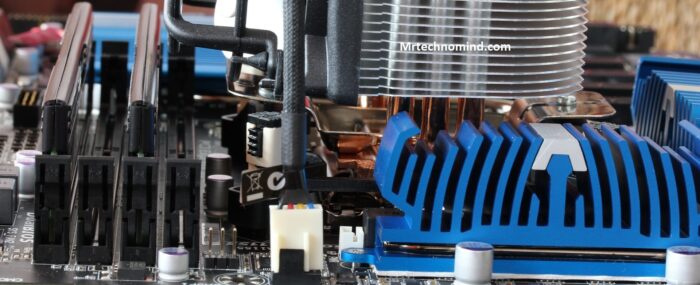
| Step | Description |
| Power Supply Connection | The power supply unit (PSU) connects to the motherboard, providing power to all components. |
| CPU Communication | The Central Processing Unit (CPU) communicates with the motherboard through the CPU socket. It sends and receives instructions to perform calculations and manage processes. |
| Memory Access | The motherboard has RAM slots where Random Access Memory (RAM) modules are installed. The CPU can access data from RAM quickly, improving system performance. |
| Peripheral Connectivity | Motherboards provide connectors for peripherals such as USB ports, audio jacks, Ethernet ports, and display connectors. These connections allow communication between the motherboard and external devices. |
| Expansion Slots | Motherboards have expansion slots, such as PCIe slots, where additional components like graphics cards, network cards, or storage expansion cards can be inserted. These slots allow for hardware expansion and customization. |
| Data Storage | The motherboard includes connectors for data storage devices like hard and solid-state drives. SATA connectors are commonly used for connecting these storage devices. |
| BIOS Initialization | When the computer is powered on, the Basic Input/Output System (BIOS) chip on the motherboard initializes the hardware, performs self-tests, and loads the operating system from the connected storage device. |
| Data Bus | The motherboard contains a data bus that transfers data between the CPU, RAM, and other components. This bus carries data and instructions between different parts of the system. |
| System Management | Motherboards often have integrated chips for system management, such as the Super I/O chip. These chips monitor temperatures, control fans, and manage input/output operations. |
| Compatibility | Motherboards must be compatible with other hardware components, such as CPU sockets, RAM, and expansion cards. Compatibility ensures proper communication and functioning of the system. |
Motherboards are the backbone of any computer system. They are printed circuit boards connecting a computer’s various components. Without a motherboard, it would be impossible for any of these parts to communicate.
So how exactly do motherboards work?
Well, first and foremost, they provide power to your computer’s various components. This includes your CPU, RAM, and storage devices. They also act as a communication hub between these parts, allowing them to send and receive data.
One of the essential things a motherboard does is manage the data flow between these components.
It does this by using various buses and ports to connect everything together. For example, most motherboards have at least one PCI Express slot for connecting graphics cards and several SATA ports for connecting hard or solid-state drives.
Overall, motherboards are an essential part of any computer system. Without them, your machine wouldn’t be able to function.
From providing power to managing data flow between components, they ensure everything runs smoothly and efficiently.
Motherboard Components
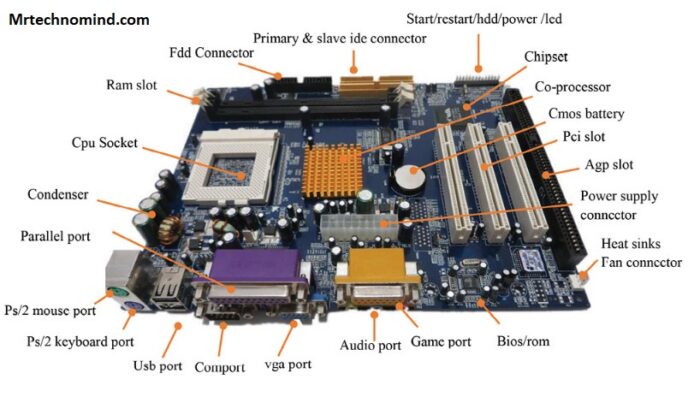
| Component | Description |
| CPU Socket | The socket where the Central Processing Unit (CPU) is installed. Different CPUs require specific socket types. |
| RAM Slots | Slots for installing Random Access Memory (RAM) modules provide temporary storage for data that the CPU needs to access quickly. |
| Expansion Slots | Slots for adding additional expansion cards, such as graphics cards, sound cards, or network cards. Common types include PCIe slots and legacy PCI slots. |
| Chipset | The chipset consists of chips that manage data flow between the CPU, memory, expansion slots, and other components. It includes the Northbridge and Southbridge or similar features. |
| BIOS Chip | The Basic Input/Output System (BIOS) chip contains firmware that initializes the hardware during startup and provides low-level system control. |
| Connectors | Various connectors for peripheral devices, including USB ports, audio jacks, Ethernet ports, display connectors (e.g., HDMI, DisplayPort), and storage connectors (e.g., SATA, M.2). |
| Power Connectors | Connectors for receiving power from the power supply unit (PSU), including the main 24-pin ATX power connector and the additional CPU power connector(s). |
| CMOS Battery | A small battery that powers the complementary metal-oxide-semiconductor (CMOS) memory, which stores the motherboard’s BIOS settings and system configuration. |
| VRM | Voltage Regulator Module (VRM) regulates and supplies power to the CPU, converting the high voltage from the power supply to the appropriate voltage levels for the CPU. |
| Clock Generator | Generates and regulates the clock signals used to synchronize the operations of various components, ensuring proper timing and synchronization within the system. |
| Capacitors | Capacitors store and supply electrical energy to stabilize voltage levels and filter out noise in the power delivery to components. They are often found near the CPU and other critical details. |
| Heat Sinks | Metal heat sinks are attached to components such as the CPU and chipset to dissipate heat generated during operation, preventing overheating and maintaining system stability. |
| Jumpers | Small pins that can be shorted with a jumper cap to change specific motherboard settings or enable/disable certain features. They are less common on modern motherboards. |
The motherboard is the main printed circuit board that connects all the components of a computer. It serves as a hub for communication between the central processing unit (CPU), memory, graphics card, storage devices, and other peripherals. A motherboard consists of various components that work together to ensure smooth operation of the system.
One of the most critical components of a motherboard is the central processing unit (CPU) socket. This is where the CPU is installed and connected to the motherboard. The CPU socket has a set of pins that align with corresponding holes on the bottom of the CPU. When inserted correctly, these pins connect the CPU’s contact points, allowing it to communicate with other components.
Another crucial component is the chipset, which controls communication between various parts of the motherboard and regulates data flow between them. The chipset contains two major parts: Northbridge and Southbridge.
The Northbridge manages high-speed communication between the CPU, RAM, and graphics card, while Southbridge handles slower functions like USB ports, hard drives, and audio.
In addition to these essential components, there are several other connectors and slots on a typical motherboard, such as RAM slots for installing memory modules, PCI-E slots for installing graphics cards or other expansion cards, SATA ports for connecting storage devices like hard drives or SSDs, USB headers for connecting external devices like printers or cameras directly to your computer case among others.
As technology advances every day, older motherboard components become obsolete over time. To keep up with modern technology standards, such as faster data transfer speeds or more advanced graphics capabilities, you may need to upgrade your system’s hardware by replacing old components like CPUs or GPUs with newer ones that meet current requirements.
Older Motherboard Components
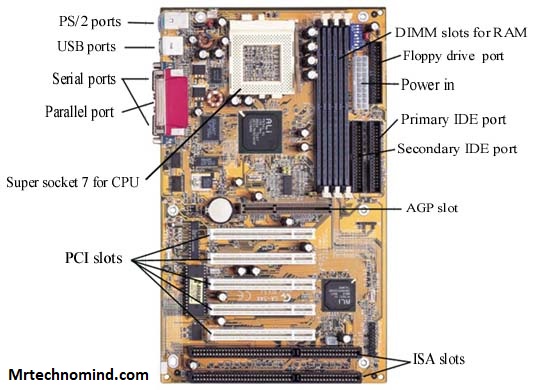
As we have learned about the various components of a motherboard, it is essential to understand that each of these parts play a crucial role in the overall functioning of a computer. Just like the organs in our body, if one component fails to work correctly, it can affect the entire system’s performance.
The BIOS chip is one such component that has undergone significant changes over time. This chip managed essential input/output functions and configuration settings in older motherboards. However, with technological advancements, the BIOS has been replaced by UEFI (Unified Extensible Firmware Interface), which provides more flexibility and security features.
Another outdated component found in older motherboards are the expansion slots. These connected additional hardware components like sound cards or graphics cards. With newer motherboards, these slots have been replaced by faster and more efficient options such as PCIe (Peripheral Component Interconnect Express).
When choosing a motherboard for your system build, it is essential to consider its form factor and type. The form factor refers to the physical size and shape of the board, while the type determines its compatibility with specific processors and memory modules. Some prevalent form factors include ATX, Micro-ATX, and Mini-ITX.
Understanding these different types and forms of motherboards is essential for anyone looking to build or upgrade their computer system. Whether you’re a gamer looking for high-performance capabilities or need a reliable method for everyday use, choosing the correct motherboard is key in ensuring optimal functionality and efficiency for your computer.
Motherboard Form Factors and Types
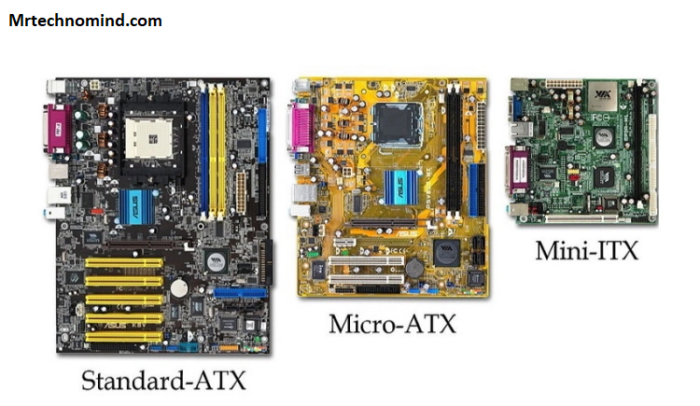
| Form Factor | Description | Common Usage |
| ATX (Advanced Technology eXtended) | The standard form factor for most desktop PCs. Larger size with more expansion slots and connectors. | Consumer desktops, gaming PCs, and workstations. |
| Micro-ATX | Smaller form factor than ATX, with fewer expansion slots. | Compact desktops, budget systems, small form factor PCs. |
| Mini-ITX | Most minor mainstream form factor, highly compact. | HTPCs (Home Theater PCs), compact systems, and low-power applications. |
| E-ATX (Extended ATX) | More prominent form factor than ATX, with additional expansion slots and connectors. | High-end gaming PCs, enthusiast systems, servers. |
| ITX (Information Technology eXtended) | A series of small form factors, including Mini-ITX, Nano-ITX, Pico-ITX, etc. | Compact and low-power systems, embedded applications. |
| BTX (Balanced Technology eXtended) | An alternative form factor to ATX, with improved thermal management. | Older systems not commonly used in modern PCs. |
| DTX (Dual Technology eXtended) | A form factor larger than Mini-ITX but smaller than Micro-ATX, providing additional expansion options. | Small form factor systems with more expandability. |
| Flex-ATX | A smaller form factor than Micro-ATX, often used in slim or compact systems. | Small form factor systems, slim desktops. |
| XL-ATX (eXtra-Large ATX) | A larger form factor than ATX, offering additional expansion slots and connectors. | High-end gaming PCs, workstation-class systems. |
Motherboard form factors and types refer to a motherboard’s size and shape. Different form factors are designed for other computer cases; choosing the right one for your system is essential.
The most common form factor is ATX, which measures 12 x 9.6 inches. Other prevalent form factors include Micro-ATX, Mini-ITX, and Extended-ATX.
Micro-ATX motherboards are smaller than ATX boards, measuring 9.6 x 9.6 inches. These boards typically have fewer expansion slots and ports than their larger counterparts but can still support high-performance components.
Mini-ITX motherboards are smaller than Micro-ATX, measuring just 6.7 x 6.7 inches. These boards are ideal for small-form-factor builds or home theatre PCs but may not be suitable for high-performance systems due to their limited expansion options.
Extended-ATX (E-ATX) motherboards are more significant than standard ATX boards, measuring up to 13 x 12 inches. These boards offer more expansion slots and ports than other form factors and are commonly used in high-end gaming systems or workstations.
To better understand the differences between these form factors, consider this numeric comparison:
1) An ATX motherboard typically has four to seven expansion slots.
2) A Micro-ATX motherboard usually has two to four expansion slots.
3) A Mini-ITX motherboard only has one expansion slot.
In summary, choosing the right motherboard form factor is crucial when building a PC as it determines what components will fit in your case and how many you can install. Various types of motherboards are available with different sizes that cater to specific needs ranging from compact builds to workstations with multiple GPUs installed.
Now that we know about motherboard form factors, let’s explore how many connections, ports or slots they come with!
How Many Connections, Ports, or Slots Are on a Motherboard?
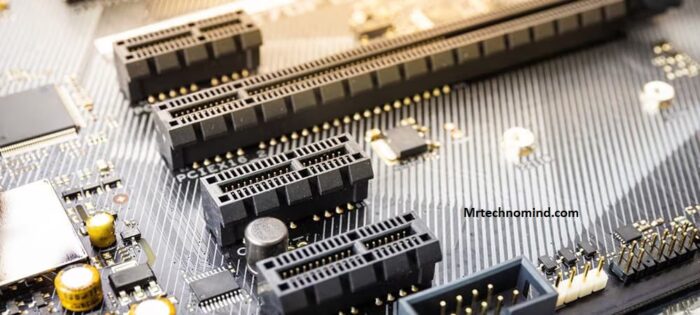
| Component/Feature | Description | Quantity on Motherboard |
| USB Ports | Connectors for Universal Serial Bus (USB) devices. | Varies (typically 4-8) |
| Audio Jacks | Connectors for audio devices such as speakers or headphones. | Typically 3-6 (varies) |
| Ethernet Port(s) | Connector(s) for wired network connectivity. | Typically 1 or 2 |
| Display Connectors | Ports for connecting displays (e.g., HDMI, DisplayPort, VGA). | Varies (typically 1-3) |
| SATA Connectors | Ports for connecting SATA-based storage devices (e.g., HDD, SSD). | Varies (typically 4-6) |
| PCIe Slots | Slots for installing expansion cards (e.g., graphics cards, network cards). | Varies (typically 2-4) |
| RAM Slots | Slots for installing RAM modules. | Varies (typically 2-4) |
| CPU Socket | Socket for installing the Central Processing Unit (CPU). | 1 |
| Power Connectors | Connectors for receiving power from the power supply unit (PSU). | Varies (e.g., 24-pin ATX, 8-pin CPU) |
| Fan Headers | Connectors for attaching cooling fans. | Varies |
| Front Panel Connectors | Connectors for buttons, LEDs, and front panel audio. | Varies |
| M.2 Slots | Slots for high-speed M.2 solid-state drives (SSDs). | Varies |
| CMOS Battery | Battery for powering the CMOS memory. | 1 |
| BIOS Chip | Chip containing the Basic Input/Output System (BIOS). | 1 |
We have learned about the different form factors and types of motherboards in the previous section. Now, let us investigate a theory that some may have about motherboards having a universal layout.
Contrary to popular belief, motherboards do not have a universal layout. Each motherboard is designed with a specific purpose in mind, whether it be for gaming, office work or multimedia usage. This means they will feature different connections, ports and slots depending on their intended use.
Motherboards typically come equipped with various connections such as USB, Ethernet, and HDMI ports. These connections allow the user to connect multiple devices, such as printers, monitors and external hard drives. Some motherboards also feature specialized connections like Thunderbolt 3, which offers faster data transfer speeds.
Have you ever noticed that the slots and connections on your motherboard are different colours? This is done intentionally to help users identify what each slot or connection is used for. For example, RAM slots are typically coloured black, while PCIe slots are coloured white or blue. This makes it easier for users to install components correctly without consulting the manual every time.
Moving onto the next section, we will investigate why specific slots and connections on a motherboard are coloured differently than others. Understanding this can help us better understand how to choose the right components for our system.
Why Are the Slots and Connections Different Colors?
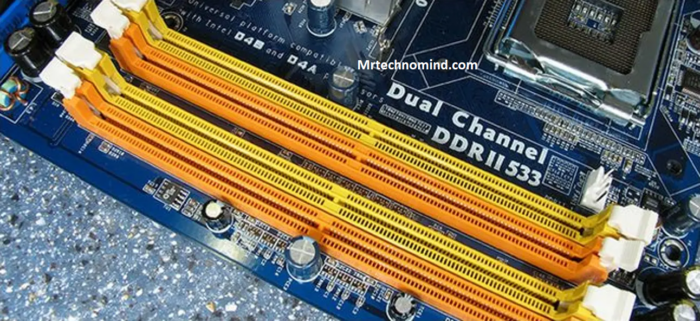
| Color | Functionality | Examples |
| Blue | USB 3.0 or USB 3.1 Gen 1 | USB 3.0/3.1 ports, headers, or internal connectors |
| Red | USB 3.1 Gen 2 or USB Type-C | USB 3.1 Gen 2 ports, titles, or Type-C connectors |
| Black | Standard USB 2.0 | USB 2.0 ports, titles, or internal connectors |
| Green | Audio connectors or audio-related functions | Audio jacks, front panel audio headers |
| Yellow | PCIe x16 or primary graphics card slot | Main graphics card slot |
| White | PCIe x1 or secondary PCIe slots | Additional expansion slots, PCIe x1 slots |
| Gray | SATA connectors or secondary storage connectors | SATA ports, SATA cables, other storage connectors |
| Orange | RAM slots or memory-related components | DIMM slots, memory-related headers or connectors |
| Silver | M.2 slots or high-speed storage connectors | M.2 slots, M.2 screws |
| Clear | CMOS battery or BIOS-related components | CMOS battery holder, Clear CMOS jumper |
| Other | It can vary depending on the manufacturer and motherboard model | Additional colour-coding for specific features or functions |
Motherboards contain various elements that allow them to function as the central hub for all computer operations. One of these components is the slots and connections, which are different colours for specific reasons. These colours are not just for aesthetics or decoration; they serve a more practical purpose.
The colour-coded slots and connections on a motherboard indicate their specific functions and compatibility with other hardware components. For example, blue slots suggest that they are PCI Express (PCIe) slots used primarily for adding expansion cards such as graphics cards, sound cards, or network adapters. The black places typically refer to PCIe x1 slots or older PCI slots used for legacy devices like modems or soundcards.
On the other hand, red-coloured ports signify USB 3.0 ports that offer faster data transfer rates than the older USB 2.0 ports that are usually identified by black or white colours. Green ports refer to audio jacks, while purple ones indicate PS/2 ports connecting keyboards and mice.
Overall, the different coloured slots and connections make it easier to identify which space to use for specific hardware components without constantly referring back to the manual provided by the manufacturer. This feature not only makes it more accessible but also helps prevent damage caused by using incompatible hardware in the wrong slot.
So, we now know why there are different coloured slots and connections present on a motherboard, but what was the first motherboard ever made? Let’s find out in the next section!
What Was the First Motherboard?
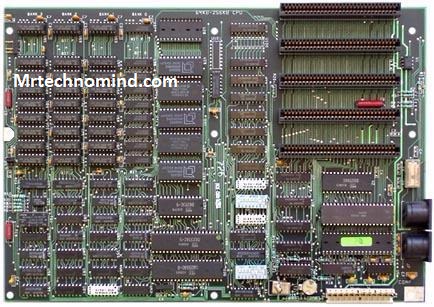
| Year | Motherboard | Description |
| 1971 | S-100 Bus | Introduced by the Altair 8800 microcomputer, it featured a backplane with slots for adding peripheral cards. |
| 1976 | Apple I | It was designed by Steve Wozniak and included a printed circuit board (PCB) with components soldered onto it, serving as a precursor to modern motherboards. |
| 1978 | IBM 5150 | The first IBM PC introduced a motherboard with slots for expansion cards and integrated peripherals like the keyboard controller. |
| 1981 | IBM PC/XT | The IBM-PC expansion bus and an 8-bit Industry Standard Architecture (ISA) slot for expansion was featured. |
| 1983 | IBM PC/AT | Introduced the 16-bit ISA bus and the AT motherboard form factor, providing enhanced expansion capabilities. |
| 1992 | Intel Advanced/ATX | Intel released the ATX form factor, introducing features like the ATX power connector, improved cooling, and better component placement. |
| 1996 | NLX (New Low Profile eXtended) | Introduced by Intel, NLX offered a compact and standardized motherboard form factor featuring riser cards for expansion. |
| 1997 | Baby AT | A smaller form factor than the AT motherboard, it allowed for more compact desktop systems. |
| 1998 | Micro-ATX | We further reduced the size of the ATX form factor, allowing for smaller desktops while maintaining some compatibility with ATX cases and power supplies. |
| 2003 | BTX (Balanced Technology eXtended) | An alternative to ATX, it aimed to improve thermal management and reduce system noise but didn’t gain widespread adoption. |
| 2004 | Mini-ITX | Introduced by VIA Technologies, it became famous for compact systems and low-power applications, featuring a small 17cm x 17cm form factor. |
As the saying goes, ‘Every great creation has a beginning.’ The same can be said for the modern motherboard. The first motherboard, also known as a PCB or printed circuit board, was created in 1981 by IBM. It was designed for their IBM PC model and quickly became the standard for all personal computers.
The first motherboard was simple, featuring only a few components, such as the CPU, RAM slots, and expansion slots. It was also relatively small compared to modern motherboards and lacked many features we take for granted today. However, it was revolutionary at the time and set the foundation for future advancements in computer technology.
Despite its humble beginnings, the first motherboard paved the way for many technological advancements that have changed our world forever. Here are five examples:
– The ability to connect multiple peripherals such as printers and scanners
– Increased processing power through multiple CPUs
– Improved graphics capabilities through dedicated graphics cards
– Faster data transfer speeds through SATA and PCIe interfaces
– Expansion of memory capacity up to several gigabytes
It’s incredible that something as simple as a PCB makes all of these capabilities possible. From its inception in 1981 to now, motherboards continue to evolve and push boundaries in computer technology.
The first motherboard may have been bare by today’s standards, but it laid the foundation for all future advancements in computer technology. Looking back at its creation over 40 years ago, we can appreciate how far we’ve come and marvel at what innovations lie ahead.
Frequently Asked Questions
1. What Are the Most Important Factors to Consider When Choosing a Motherboard?
When selecting a motherboard, it is essential to consider various factors that can impact the overall performance of your computer.
Firstly, you should identify the processor type and socket compatibility as this will determine which motherboards will work with your CPU.
Secondly, ensure the motherboard has enough expansion slots and ports for any additional components or peripherals you may need to install.
Consider the number of RAM slots available and supported memory speeds for optimal performance.
Additionally, think about the motherboard size and ensure it fits appropriately into your case.
Finally, consider other features such as onboard audio, networking capabilities, and BIOS options that can affect system stability and ease of use.
2. Can I Upgrade My Motherboard Without Having to Reinstall My Operating System?
Have you ever tried changing the tires on a car while it’s still moving? That’s essentially what it would be like to upgrade your motherboard without reinstalling your operating system.
Your motherboard is like the foundation of your computer, and changing it would mean replacing a crucial piece of hardware that helps everything run smoothly.
While some components, such as the CPU or RAM, can be swapped out without much hassle, upgrading the motherboard requires complete disassembly and reassembly of your computer.
This means you’ll need to reinstall your operating system and all of your software from scratch.
So while it may be tempting to try and skip this step, ensuring everything runs smoothly after an upgrade is crucial.
3. How Does the Chipset on a Motherboard Affect Its Performance?
The chipset on a motherboard plays a crucial role in determining its performance.
It acts as the communication hub between various components, such as the processor, memory, and storage devices.
The chipset controls data transfer between these components and ensures they work together seamlessly.
A high-end chipset can significantly enhance a motherboard’s performance by improving system stability, increasing data transfer speeds, and supporting advanced features like overclocking.
Conversely, a low-end chipset may limit the overall capabilities of a motherboard and result in slower processing speeds or limited compatibility with specific hardware components.
Therefore, choosing a motherboard with a suitable chipset that meets your needs is essential based on your performance, features, and budget priorities.
4. What Types of Expansion Cards Can Be Added to a Motherboard?
Depending on the available slots, several types of expansion cards can be added to a motherboard.
Graphics cards can be added to enhance the computer’s visual performance, while sound cards improve audio quality.
Network interface cards enable connection to a network, and storage controller cards allow for additional storage devices.
Expansion cards can significantly enhance a computer system’s functionality and give users customised options.
The type and number of expansion slots available on a motherboard may vary, so checking compatibility before purchasing an expansion card is essential.
5. Is There a Limit to the Amount of Ram That Can Be Installed on a Motherboard?
There is a limit to the amount of RAM that can be installed on a motherboard, and it varies depending on the specific motherboard model.
According to recent statistics, motherboards’ average maximum RAM capacity ranges from 32GB to 128GB. However, some high-end motherboards can support up to 768GB of RAM.
It’s essential to check your motherboard’s specifications before purchasing additional RAM to ensure compatibility and avoid any potential issues.
Conclusion
So there you have it, folks! The motherboard is the backbone of your computer, connecting all the different components together to create a cohesive unit.
When choosing a motherboard, it’s essential to consider factors like compatibility with your chosen processor, the number of expansion slots available, and the speed of data transfer.
If you want to upgrade your motherboard without reinstalling your operating system, it’s possible – but do your research first to ensure that everything will work seamlessly together.
And don’t forget about the chipset – this little piece of hardware can have a big impact on performance!
With so many options for expansion cards and RAM installation, there’s plenty of room for customization when building your perfect PC.
Remember: the motherboard is the heart and soul of your machine, so choose wisely!